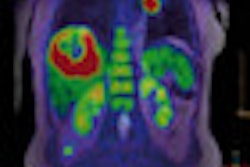German researchers are reporting promising results in the use of PET/MRI to detect malignant tumors in the head and upper neck area, according to a study published online February 10 in European Radiology.
Researchers tested a prototype hybrid PET/MR scanner (BrainPET, Siemens Healthcare) and concluded that the MR images showed "excellent image quality," with no recognizable artifacts caused by the specially designed PET detector array that fits inside the MRI magnet bore.
The lead author of the study is Andreas Boss, MD, from the department of diagnostic and interventional radiology at Eberhard-Karls University.
The benefit of the hybrid imaging technology is the ability to combine the anatomical resolution and soft-tissue contrast of MRI with PET's ability to evaluate metabolism and molecular processes. Boss and colleagues collaborated on a similar study last year, which had success in using the PET/MRI system on patients with brain tumors.
The new study enrolled eight patients with head and neck cancer (seven males and one female, with a median age of 65.5 years) between November 2008 and November 2009. All patients received whole-body FDG-PET/CT imaging for staging of their cancer, then immediately received PET/MRI of the head and upper neck region without additional radiotracer.
Imaging protocol
Patients were given an intravenous injection of 350 to 399 MBq of FDG (4 MBq/kg based on body weight) prior to the PET/CT scan from the upper thorax to the midthigh.
PET/CT data acquisition (Hi-Rez Biograph 16 with 3D PET, Siemens) started with the administration of 100 to 120 mL of contrast (Ultravist, Bayer Schering Pharma) for the CT scan and bolus injection of the same contrast agent for the head and neck imaging.
CT was followed by PET data acquisition 60 minutes after the radiotracer injection with three minutes per position for body imaging and four minutes for the head and neck imaging.
All PET/MRI exams were performed with the hybrid PET/MRI system to image the head and upper neck region. The system features an MRI-compatible lutetium oxyorthosilicate-based PET insert, which fits into a slightly modified 3-tesla whole-body MRI scanner (BrainPET and Magnetom Tim Trio, Siemens). PET and MRI data acquisition started simultaneously 30 to 60 minutes after PET/CT imaging.
Two board-certified radiologists and one board-certified nuclear medicine physician evaluated the PET/CT and PET/MR images based on the visualization of the anatomical structures, malignant tumors, and image artifacts.
Reader evaluation
The readers concluded that the MR images acquired during simultaneous PET acquisition "exhibited excellent image quality," according to Boss and colleagues, similar to conventional 3-tesla MRI "without any recognizable additional artifacts or distortions caused by the PET insert."
They noted that the PET datasets showed "slight streak artifacts, which were most prominent in the sagittal and coronal reformations" but did not adversely affect visualization of the tumors.
PET images obtained with the PET/MRI system also exhibited more detailed resolution and greater image contrast compared to those from the PET/CT system.
"Because of the higher resolution of the PET component within the PET/MRI system in comparison to the PET component of the PET/CT system, small anatomical structures such as orbicular muscles were better delineated and showed a better contrast to the background," the authors wrote.
Prototype limitation
The authors noted one limitation of the system: "One disadvantage of this prototype system mainly designed for brain imaging is the small axial field-of-view of the PET component of approximately 19.1 cm," they wrote.
The axial field-of-view of the PET insert only reached the level II lymph node regions, while the hypopharynx and larynx were outside the field-of-view.
In addition, no malignant tumor tissue was detected within the imaging region of the PET insert in two patients. In one patient, no residual tumor tissue was found on either PET/MRI or PET/CT imaging after radiation therapy. In one other patient, a metabolically active lymph node metastasis was identified with the PET/CT system, which was outside the field-of-view of the PET/MRI system.
With that shortcoming, the authors concluded that simultaneous PET/MRI of the head and upper neck region is "feasible with the available prototype PET/MRI system. Thus, hybrid PET/MRI can be used to obtain the often complementary information from MR and PET imaging very efficiently and with optimal spatial and temporal coregistration."



















